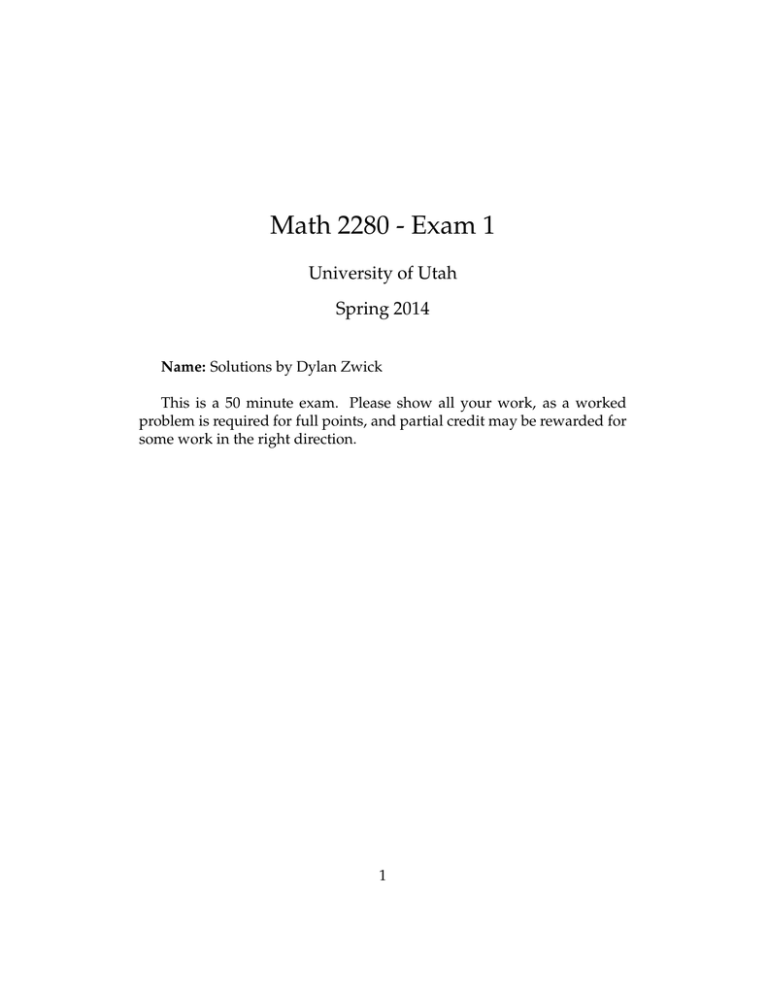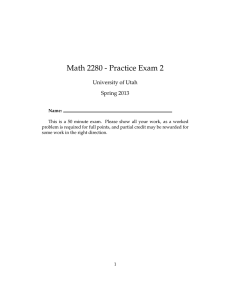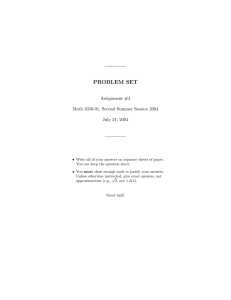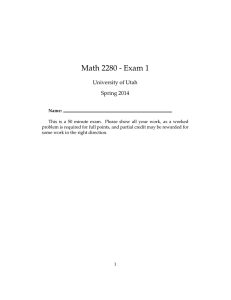Math 2280 - Exam 1 University of Utah Spring 2014
advertisement

Math 2280 - Exam 1 University of Utah Spring 2014 Name: Solutions by Dylan Zwick This is a 50 minute exam. Please show all your work, as a worked problem is required for full points, and partial credit may be rewarded for some work in the right direction. 1 1. (15 Points) Differential Equation Basics (a) (5 points) What is the order of the differential equation given below?1 2 ′′ x2 y 3y (4) − ex y 2 y ′ + 3xy = 42 Solution - Fourth Order. (b) (5 points) Is the differential equation given below linear? y (3) + y 3 = x + 3 Solution - No. (c) (5 points) On what intervals are we guaranteed a unique solution exists for the differential equation below? (x + 1)y ′ + e2x y = x2 + 2 x−1 Solution - We can rewrite the differential equation as: y′ + e2x x2 + 2 y= . (x + 1) (x + 1)(x − 1) Where guaranteed a unique solution exists on any interval where e2x x2 + 2 both and are continuous. These are the (x + 1) (x + 1)(x − 1) intervals (−∞, −1), (−1, 1), and (1, ∞). 1 Extra credit - Solve this differential equation! Just kidding. Do not attempt to solve it. 2 2. (10 points) Phase Diagrams Find the critical points for the autonomous equation: ciP = kP(P — M)(H — P), where k, M, ii > 0 and MT > I-I. Draw the corresponding phase diagram, and indicate if the critical points are stable, unstable, or semistable. The critical points are the values of P for which = 0. These are the points P = 0, H, MT. The corresponding phase diagram is: Solution - - U /‘i 1-i From the phase diagram we see that P points, while P H is unstable. 3 = 0, II are stable critical 3. (20 Points) Separable Equations Solve the initial value problem dP = 5P 2 , dt where P (0) = 2. Why would this be an example of a “doomsday” equation? According to this differential equation, when is “doomsday”? Solution - We can rewrite this differential equation as dP = 5dt. P2 Integrating both sides we get − 1 = 5t + C. P Solving for P we get P (t) = 1 . C − 5t 1 Plugging in the initial condition P (0) = 2 we get C = , and so 2 P (t) = 2 . 1 − 10t 1 we have a This is called a “doomsday” equation because at t = 10 1 vertical asymptote. So, t = is “doomsday” for this equation. 10 4 4. (35 points) Linear Differential Equations (a) (20 points) Solve the initial value problem 2 y ′ + 4xy − 3y + 3e−2x = 0, y(0) = 4. Solution - We can rewrite this equation as 2 y ′ + (4x − 3)y = −3e−2x . This is a first-order linear differential equation. The integrating factor is R ρ(x) = e (4x−3)dx = e2x 2 −3x . Multiplying both sides by this integrating factor we get e2x 2 −3x y ′ + (4x − 3)e2x 2 −3x y= d 2x2 −3x e y = −3e−3x . dx Integrating both sides we get e2x 2 −3x y = e−3x + C 2 ⇒ y(x) = e−2x + Ce−2x 2 +3x . Plugging in the initial condition we get 4 = y(0) = 1 + C ⇒ C = 3. So, the unique solution to the initial value problem is 2 y(x) = e−2x + 3e−2x 5 2 +3x . (b) (15 points) Find the general solution to the differential equation y ′′ − y ′ − 6y = 0. Solution - The corresponding characteristic equation is r 2 − r − 6 = (r − 3)(r + 2). So, the roots are r = −2, 3, and the general solution to the differential equation is y(x) = c1 e3x + c2 e−2x . 6 5. (20 points) Euler’s Method Use Euler’s method with step size h = 1 to estimate y(2), where y(x) is the solution to the initial value problem dy = 2x + 3y, dx y(0) = 2. Solution - Using Euler’s method our estimate for y(1) is y(1) ≈ 2 + (2(0) + 3(2)) = 8. Our estimate for y(2) is y(2) ≈ 8 + (2(1) + 3(8)) = 34. 7



